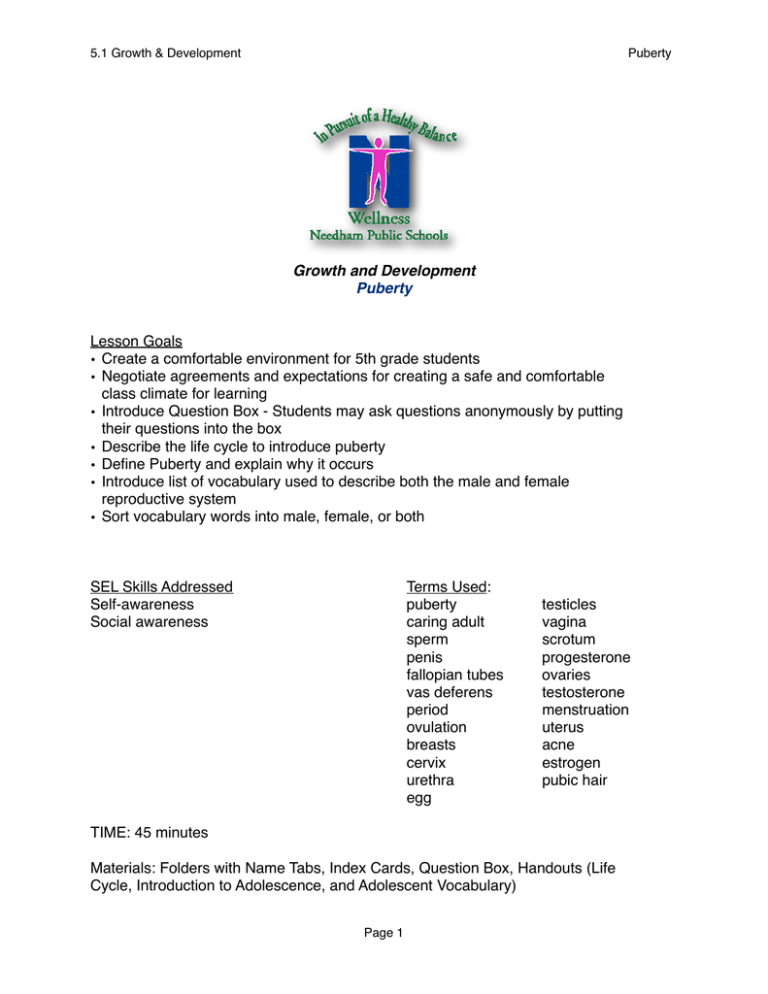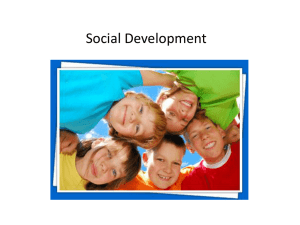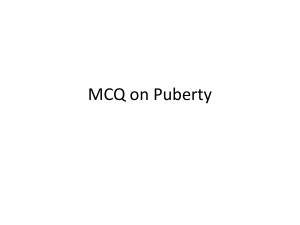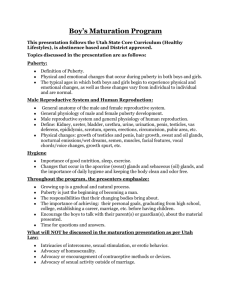Growth and Development Puberty Lesson Goals • Create a
advertisement

5.1 Growth & Development Puberty Growth and Development Puberty Lesson Goals • Create a comfortable environment for 5th grade students • Negotiate agreements and expectations for creating a safe and comfortable class climate for learning • Introduce Question Box - Students may ask questions anonymously by putting their questions into the box • Describe the life cycle to introduce puberty • Define Puberty and explain why it occurs • Introduce list of vocabulary used to describe both the male and female reproductive system • Sort vocabulary words into male, female, or both SEL Skills Addressed Self-awareness Social awareness TIME: 45 minutes Terms Used: puberty caring adult sperm penis fallopian tubes vas deferens period ovulation breasts cervix urethra egg testicles vagina scrotum progesterone ovaries testosterone menstruation uterus acne estrogen pubic hair Materials: Folders with Name Tabs, Index Cards, Question Box, Handouts (Life Cycle, Introduction to Adolescence, and Adolescent Vocabulary) Page 1 5.1 Growth & Development Puberty Activity 1: Creating a Respectful Learning Environment Greet students and introduce the focus of the lesson. Remind students that in the beginning of the year we go over our rules and expectations for student behavior in our physical education classes. Today we will be sharing our rules and expectations for our health class. Assign Duties: Designate student volunteers to pass out class materials (folders, index cards, handouts). You can have the same students do this each class, or you can assign new volunteers for each class. Have student volunteers pass out materials. Ask students to print their names on the tab of their folders but do not put their names on the index cards. Pass out the Creating a Respectful Learning Environment handout. Remind students that each, and every student in this class has a responsibility to contribute to making our classroom a safe and comfortable place to learn, ask questions, and participate in meaningful conversations. There are many ways to behave that will result in the creation of a safe learning environment. Ask students to take a few minutes to respond to the three questions listed on the handout on their own. 1. Students might feel embarrassed or get silly when the class discusses issues related to puberty because... 2. How do you think students should act so that everyone can feel comfortable and be more open to learning about puberty? 3. What are some classroom rules and routines we could create to help us all feel more emotionally safe and comfortable? Once students have had an opportunity to write down some of their own thoughts, put them in small groups and ask them to agree on the three most important statements for categories 2 and 3. When students have finished, engage them in a conversation that allows them to share their thoughts. Conclude the conversation with a list of classroom guidelines that the entire group can agree upon. It would be helpful to post this list on cardboard or newsprint so you can bring it in to every class or leave it up on the classroom wall during the entire unit. Page 2 5.1 Growth & Development Puberty Activity 2: Introduce the Anonymous Question Box Show students your “question box” and explain how it works. At the beginning of each class, each student will receive an index card. If students have a question that they donʼt feel sure about, or donʼt want to ask out loud, they can write it on the index card. They should not put their names on the card (for anonymity). At the end of each class, you will collect all the index cards and put them in the box. Beginning in the second class, the questions will be answered as frequently as the teacher determines. NOTE: The teacher will also pose a question at the beginning of each class (e.g., What is your favorite television show?), which students should answer if they do not have a class-related question to write on their paper. Everyone will be expected to write something on their index card and place it in the box as they leave the room in order to preserve the anonymous nature of the activity. Any questions that the teacher feels are inappropriate (due to language or not pertaining to the content in class) will not be answered. Activity 3: Growing Towards Adulthood Pass out the Growing Towards Adulthood handout. Inform students that the pictures and descriptions represent stages of life -- some of which they have already gone through. Although we all progress through these stages, we do not go through them at the same time or same pace. This unit will focus on the beginning stages of adolescence. This is a time when both girls and boys go through puberty. Puberty is a universally experienced transition from childhood to adulthood characterized by physical and emotional changes. Puberty marks a time in our lives when we start to take more responsibility for taking care of ourselves -- physically, socially, emotionally. Activity 4 - Vocabulary Used in Conversations About Puberty Pass out the Vocabulary Used in Conversations About Puberty handout. The purpose of this handout is to let students see all the vocabulary words that will be used in this unit. When students first see these words, they may giggle or feel a bit embarrassed. This is a natural reaction. Students will become more comfortable as they work through this lesson. Note: It is helpful for the teacher to read each of the vocabulary words out loud. This models the use of the proper terms for the male and female anatomy in a respectful tone and manner. It also provides students the correct pronunciation for each word. Each vocabulary word is associated with either the male, female, or both males and females. Have students write each word in the column where they think it belongs. Page 3 5.1 Growth & Development Puberty If time permits, go over the correct responses and give students an opportunity to make changes and adjustments to their work so that they have all the words in the correct column. If time is running out, begin the next class with this as a review. Activity 5 - Closure Collect folders and have students put their index cards into the question box. Inform students that our next lesson will focus on the emotional changes people go through during puberty. Page 4 5.1 Growth & Development Puberty Creating a Respectful Learning Environment Names ______________________________________________________ _______________________________________________________ Please give 3 or more responses to the following: 1) Students might get embarrassed or silly when the class discusses issues related to puberty because... 2) How do you think students should act so that everyone can feel comfortable and be more open to learning about puberty? 3) What are some classroom rules and routines we could create to help us all feel more emotionally safe and comfortable? Page 5 5.1 Growth & Development Puberty Growing Towards Adulthood Infant: birth to 11 months Early Childhood (toddler): 1-3 Middle Childhood: 3-5 Late Childhood: 5-8 (ends at the onset of puberty) Adolescence: Anywhere between 8-18 Adulthood: Begins between 18-20 (whenever Adolescence ends. Page 6 5.1 Growth & Development Puberty Vocabulary Used in Conversations About Puberty As we begin a study of puberty, it is interesting to see what it is you already think you know about our bodies and how they grow and change during puberty. Adolescence is the period of growth between being a child and becoming a young adult. An integral part of adolescence is a process called Puberty. See if you can identify and label the vocabulary we will be using as we study both the male and the female reproductive systems. Donʼt worry if you donʼt know all the answers, just give your best guess and we will go over these to make sure you now which is which. Just doing this activity will help introduce you to some of the vocabulary we will be using in this unit. ___________________________________________________________________ sperm penis fallopian tubes vas deferens period emotions egg MALE ovulation breasts cervix urethra deeper voice muscles testosterone pubic hair estrogen acne uterus sweat menstruation BOTH Page 7 facial hair testicles vagina scrotum progesterone FEMALE 5.1 Growth & Development Puberty Teacher Talking Points for Classroom Expectations and Protocols Classroom expectations will be created in part, by studentsʼ responses in the “Why Do We Act Silly When We Talk About Puberty” discussion. Remind students that we are all coming into this class with different experiences and different degrees of knowledge, information and misinformation. The purpose of this unit is to make sure everyone has the same knowledge and information. Classroom expectations and protocols should be designed to ensure that all students feel emotionally safe talking about body changes and sexual health and to ensure that lessons run smoothly. Some examples may include (but not limited to) the following: One person speaks at a time: This will ensure that all voices are heard. Respect Different Ideas and Opinions: This will encourage students to share their thoughts and ideas. Use Proper Scientific Language in Class: This will prevent students from using a variety of different slang terms when referring to body parts. Confidentiality: No sharing of personal information outside the classroom. It is OK to share the concepts and ideas that are covered in class, but it is not OK to talk about who said what. Note to teacher: Be sure to include confidentiality in the list of agreements and expectations and to explain your role as a trusted adult and mandated reporter. Students can expect confidentiality from a teacher only if the teacher has no concerns about the studentʼs safety. In the state of Massachusetts, it is a legal requirement to report suspected abuse and neglect on behalf of certain vulnerable groups of people, including people under the age of 18. Job Assignments: Individual students are assigned to pass out folders, handouts, questions cards, etc. This will help the teacher get organized and started on time. All Questions are welcome: This will encourage students to ask whatever is on their mind. Introduce the concept of the confidential questions. Each teacher will have a question box. All students will be given a note card at the beginning of each lesson. They can write their questions onto the note card. All note cards are collected at the end of each lesson and put into the box (whether they have a question written on them or not). The teacher will address the questions in the next class. Page 8



